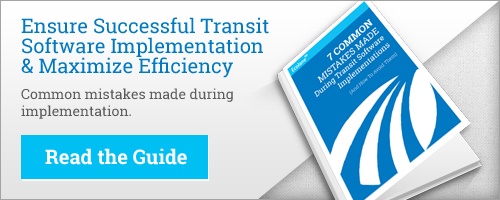Implementing new transportation software should make a company's operation run more smoothly, but all too often it ends up causing unnecessary headaches. Knowing the 5 most forgotten steps when implementing transportation software helps make the process of launching your transportation software an easy and headache-free one.
1. Communicating with stakeholders (customers, partners, and employees): All too often, companies neglect to inform their customers, partners, and employees that they are implementing new software. Missing this critical step causes unnecessary confusion and often results in pain throughout the company. It is important to let customers and riders know exactly what will change with the new software implementation, including:
- Changes in reservation process: Customers need to know what they should do differently to ensure that their reservation for a pick up or drop off is received and approved.
- Changes in pick up and drop off times: If a customer's normal schedule is supposed to change, they need to know well ahead of time so they can plan accordingly. Customers count on transit drivers and their normal delivery, and an unexpected change in delivery creates distrust and in some cases, real hardship for those involved.
- Changes in enforcement of any existing policies: Even though every company has policies in place it should be enforcing, many of these slide as years go by. Make sure all riders are aware of any new policies and use the opportunity to reinforce existing policies once again.
Once customers, riders, and partners are alerted to any new changes that the implementation of new software will bring, it's time to start implementing the changes that will take place before the software goes live. This will serve as a sort of test run to iron out the kinks in the new process, and customers and riders can offer constructive feedback along the way. All customers, partners, and riders should be aware that these changes are being implemented so they can get used to the new system and new way of doing things. Communication is key throughout this process. Make sure employees are aware of why these changes are being made and what positive impact the new transportation software will have. This is important to ensure they don't feel like as if they’re being forced into a new routine without good reason.
2. Reviewing data: It is tempting to simply export data from an old system to a new one (assuming that’s possible), but this is optimal time to clean up the old data. Going through a customer list and making sure it is accurate is a great step towards getting control of your data back. Are all current customers included with accurate contact information? Does data from old customers who no longer travel exist? Taking the time to get an accurate assessment of data will only improve the process of implementing new software.
3. Properly training management: Managers may not immediately understand how a new route scheduling software works. They often need to be trained so that they can use the new software. They also need to be able to answer questions from riders as well as other employees. In addition, managers who are well trained and understand the significance of the new transportation software will be able to accurately and enthusiastically share the goals and vision of the company’s forward progress.
4. Planning out the go-live process: The go-live process requires all hands on deck, so having a full staff is vital. Plan out the target date and procedures and communicate these well ahead of time so that everyone knows they are needed. Customers will be calling with questions so have resources available that they can refer to when problems arise. In order to solve customer problems in a standardized manner, it is important to work with your software provider to produce a script to hand out to employees. This will help ensure that all stakeholders are receiving the same answers. The script should include the following, at a minimum:
- Prepared answers to common customer questions
- Procedure list that the customer can follow for specific or common service questions
- A clear method for unexpected issues that allow for quick management follow up.
5. Celebrating a successful go-live: When a company follows the above 4 steps instead of avoiding or forgetting them, the chances of a a successful go-live are increased. This is cause for celebration! Take some time to acknowledge and appreciate everyone who helped make the go-live a success, and thank customers for their continued loyalty and their patience during the implementation process.
If you have any questions about the implementation of your transportation software please contact us at Ecolane.
About the Author

Ecolane
Read Ecolane's blog articles for perspective, opinion and information on transit and paratransit issues.
%20(200%20x%20100%20px).png)

